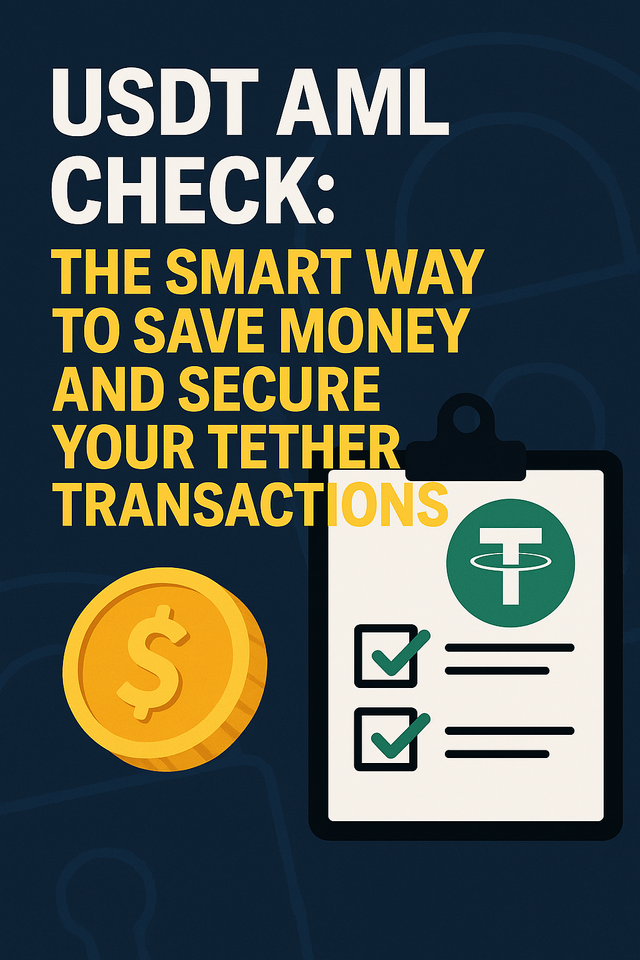Usdt aml check: A Complete Educational Guide for Developers and Crypto Users
Introduction
Tether (USDT) is the world’s most popular stablecoin. It powers DeFi apps, crypto exchanges, cross-border payments, and trading strategies.
But with such high adoption comes a major problem: fraud, scams, and compliance risks.
If you send USDT to a suspicious wallet, your funds might be frozen, flagged, or lost forever.
That’s why tools like Usdt aml check are critical.
This article is a complete educational guide on how to use Usdt aml check effectively — for both developers and everyday crypto users.
What is Usdt aml check?
Usdt aml check is a blockchain compliance tool that helps users analyze USDT transactions and wallets.
It scans addresses and transactions against:
- Blacklists (known fraud wallets)
- AML databases
- Suspicious activity patterns
The system then generates a risk score (low, medium, or high).
This empowers users to make informed financial decisions before sending or receiving USDT.
Why Usdt aml check is Important
Unlike banks, blockchains don’t automatically screen transactions.
Without AML checks, users face risks:
- Sending funds to blacklisted wallets
- Losing access to funds due to freezes
- Increased exposure to fraud and scams
- Regulatory penalties for businesses
As Coinbase explains, compliance and transparency are key to mass adoption of crypto.
Usdt aml check addresses these concerns by making stablecoin usage safer, cheaper, and more reliable.
Key Features
- Wallet Screening – Detects suspicious or blacklisted addresses
- Transaction Risk Scoring – Generates low/medium/high risk reports
- Real-Time Analysis – Instant results before executing transactions
- Data Privacy – Protects user information while ensuring compliance
- API Integration – Automates AML checks for businesses and developers
Pros & Cons
Pros
- Prevents costly mistakes and frozen funds
- Saves money on failed transactions
- Protects individuals and businesses equally
- Easy-to-use interface + developer-friendly API
Cons
- Occasional false positives
- Requires updates for new fraud methods
- Businesses may need staff training for integration
Step-by-Step Guide: How to Use Usdt aml check
This section is practical and hands-on — follow along like a tutorial.
1. Access the Platform
- Visit the Usdt aml check website
- Enter the wallet address or transaction hash you want to analyze
2. Run the Scan
- Start the check
- The tool will query multiple databases and blocklists
- Results appear within seconds
3. Read the Risk Report
- Low risk = Safe to transact
- Medium risk = Proceed with caution, maybe double-check
- High risk = Avoid transaction to protect your funds
4. Apply Cost-Saving Best Practices
- Always run checks before sending USDT
- Batch multiple wallet scans to save time
- Use API integration if you’re a business handling large volumes
5. Automate for Businesses
- Connect Usdt aml check via API
- Automate daily/weekly scans of transactions
- Reduce compliance overhead and manual costs
How Usdt aml check Minimizes Costs
Usdt aml check isn’t just about compliance — it’s about profitability:
- Avoid frozen funds → Saves capital
- Prevent failed transactions → No wasted network fees
- Reduce legal risks → Avoid compliance fines
- Boost efficiency → Less manual checking, more automation
- Build trust → Safe transactions attract clients and partners
As Binance highlights, compliance frameworks increase trust and liquidity — which directly translates to profitability.
Best Practices for Developers and Users
- Developers: Integrate Usdt aml check API into dApps for automated risk screening
- Traders: Run checks before moving large amounts of USDT
- Businesses: Automate compliance reports to lower staff costs
- Investors: Use risk reports to protect long-term holdings
Real-World Use Cases
- Exchanges → Screen deposits/withdrawals to avoid handling illicit funds
- DeFi Platforms → Protect smart contracts from risky interactions
- Retail Users → Avoid scams and fraudulent wallets
- Enterprises → Automate AML processes for auditing and cost efficiency
According to Forbes, stablecoins like USDT will face increasing regulatory oversight. Tools like Usdt aml check make adoption smoother.
FAQ
1. What is Usdt aml check used for?
It screens USDT wallets and transactions for AML risks.
2. Can individuals use it?
Yes, both individuals and businesses can benefit.
3. Does it save money?
Yes — by preventing frozen/failed transactions and compliance fines.
4. Is it privacy-friendly?
Yes, it balances AML with strong data protection.
5. Can it be automated?
Yes, via API for exchanges, businesses, and DeFi platforms.
6. Why focus on USDT?
USDT is the most widely used stablecoin, making it high-risk for fraud.
Conclusion
The Usdt aml check tool is more than compliance — it’s about cost savings, safety, and profitability.
By identifying risks before transactions, it protects users from fraud, reduces unnecessary costs, and strengthens trust in the USDT ecosystem.
For traders, businesses, developers, and investors, it’s an essential resource for safe and profitable participation in crypto.
